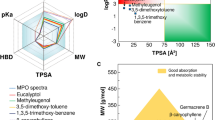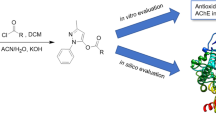Abstract
The frequency of Alzheimer’s disease (AD) is growing rapidly with longer life expectancy and the consequent increase of people with a high risk of neurodegenerative diseases. Anacardic acid (AA) has several pharmacological actions, such as antioxidants, anticholinesterase, and anti-inflammatory, which are related to the protection against aging disorders. Also, the metals copper and zinc are co-factors of antioxidant enzymes that can be associated with AA to improve brain-protective action. This study aimed to evaluate the potential of AA metal complexes using copper and zinc chelators to produce potential agents against Alzheimer’s disease. For this purpose, Cu and Zn were linked to AA in the ratio of 1:1 in a basic medium. The complexes’ formation was confirmed by ultraviolet and visible spectroscopy. The toxicity was evaluated in the zebrafish model, and other information related to AD was obtained using the zebrafish model of anxiety. AA-Zn and AA-Cu complexes showed better antioxidant action than free AA. In the anti-AChE activity, AA was like the AA-Cu complex. In models using adult zebrafish, no toxicity for AA complexes was found, and in the locomotor model, AA-Cu demonstrated possible anxiolytic action. In in silico experiments comparing AA and AA-Cu complex, the coupling energy with the enzyme was lower for the AA-Cu complex, showing better interaction, and also the distances of the active site amino acids with this complex were lower, similar to galantamine, the standard anti-AChE inhibitor. Thus, AA-Cu showed interesting results for more detailed study in experiments related to Alzheimer’s disease.






Similar content being viewed by others
References
Awad SH (2012) Synthesis and characterization of some mixed – ligand complexes containing salicylic acid and pyridine with some metal ions. Journal of Al-Nahrain University 15:23–29
Batista FLA, Campos AR, de Sousa CÁPB et al (2017) Adult zebrafish (Danio rerio): an alternative behavioral model of formalin-induced nociception. Zebrafish 14:422–429. https://doi.org/10.1089/zeb.2017.1436
Bushra Begum A, Rekha ND, Vasantha Kumar BC et al (2014) Synthesis, characterization, biological and catalytic applications of transition metal complexes derived from Schiff base. Bioorg Med Chem Lett 24:3559–3564. https://doi.org/10.1016/j.bmcl.2014.05.046
Cabral A, De OM, Albuquerque A et al (2016) Ingestão e coeficiente de variabilidade de nutrientes antioxidantes por gestantes com pré-eclâmpsia. Rev Port Cardiol 35:469–476. https://doi.org/10.1016/j.repc.2016.03.005
Catalani S, Paganelli M, Gilberti ME et al (2018) Free copper in serum: an analytical challenge and its possible applications. J Trace Elem Med Biol 45:176–180. https://doi.org/10.1016/j.jtemb.2017.11.006
Cheung J, Rudolph MJ, Burshteyn F et al (2012) Structures of human acetylcholinesterase in complex with pharmacologically important ligands. J Med Chem 55:10282–10286. https://doi.org/10.1021/jm300871x
Cummings J, Lee G, Mortsdorf T et al (2017) Alzheimer’ s disease drug development pipeline : 2017. Alzheimer’s & Dementia: Translational Research & Clinical Interventions 3:367–384. https://doi.org/10.1016/j.trci.2017.05.002
De LimaMachado SJ, Neto M (2014) Effects of immature cashew nut-shell liquid (Anacardium occidentale ) against oxidative damage in Saccharomyces cerevisiae and inhibition of acetylcholinesterase activity. Genet Mol Res. https://doi.org/10.4238/vol7-3gmr473
Dean KM, Qin Y, Palmer AE (2012) Visualizing metal ions in cells: an overview of analytical techniques, approaches, and probes. Biochimica et Biophysica Acta - Molecular Cell Research 1823:1406–1415. https://doi.org/10.1016/j.bbamcr.2012.04.001
Ellman GL, Courtney KD, Andres V, Featherstone RM (1961) A new and rapid colorimetric determination of acetylcholinesterase activity. Biochem Pharmacol 7:88–95. https://doi.org/10.1016/0006-2952(61)90145-9
Frasco MF, Fournier D, Carvalho F, Guilhermino L (2005) Do metals inhibit acetylcholinesterase (AchE)? Implementation of assay conditions for the use of AchE activity as a biomarker of metal toxicity. Biomarkers 10:360–375. https://doi.org/10.1080/13547500500264660
Hanwell MD, Curtis DE, Lonie DC, et al (2012) Avogadro: an advanced semantic chemical editor, visualization, and analysis platform. J Cheminform 4:17. https://doi.org/10.1186/1758-2946-4-17
Fymat AL (2018) Current Opinions in Neurological Science Alzheimer’ s Disease : A Review 2:415–436
Huang Y, Zhang J, Han X, Huang T (2014) The use of zebrafish (Danio rerio) behavioral responses in identifying sublethal exposures to deltamethrin. Int J Environ Res Public Health 11:3650–3660. https://doi.org/10.3390/ijerph110403650
Kara E, Gunay M, Cicioglu I et al (2010) Effect of zinc supplementation on antioxidant activity in young wrestlers. Biol Trace Elem Res 134:55–63. https://doi.org/10.1007/s12011-009-8457-z
Mendes NM, de Oliveira AB, Guimarães JE et al (1990) Atividade moluscicida da mistura de ácidos 6-n-alquil salicílicos (ácido anacárdico) e dos seus complexos com cobre (II) e chumbo (II). Rev Soc Bras Med Trop 23:217–224. https://doi.org/10.1590/s0037-86821990000400007
Molecular M, Field F, Halgren TA (1996) Merck Molecular Force Field 17:490–519
Morais SM, Silva KA, Araujo H et al (2017) Anacardic acid constituents from cashew nutshell liquid: NMR characterization and the effect of unsaturation on its biological activities. Pharmaceuticals 10:1–10. https://doi.org/10.3390/ph10010031
Nelson L, Tabet N (2015) Slowing the progression of Alzheimer’s disease; what works? Ageing Research Reviews 23:193–209. https://doi.org/10.1016/j.arr.2015.07.002
OECD (1992) OECD 203 fish, acute toxicity test. Guideline for the testing of chemicals 203:1–9
Patil DN, Patil SA, Id SS, Id JPJ (2019) Comparative biophysical characterization: a screening tool for acetylcholinesterase inhibitors. PLOSONE 14:1–28
Philip JYN, Francisco JDC, Dey ES et al (2008) Isolation of anacardic acid from natural cashew nutshell liquid (CNSL) using supercritical carbon dioxide. Journal of Agricultural and Food Chemistry 56:9350–9354. https://doi.org/10.1021/jf801532a
Prasad AS, Bao B, Beck FWJ et al (2004) Antioxidant effect of zinc in humans. Free Radical Biol Med 37:1182–1190. https://doi.org/10.1016/j.freeradbiomed.2004.07.007
Rafael A, Jan D, David K et al (2014) Ac ce p te us cr t. J Mol Graph Model. https://doi.org/10.1016/j.jmgm.2014.11.010
Saddam Hossain M, Roy PK, Ali R et al (2018) Selected pharmacological applications of 1st row transition metal complexes: a review. Clinical Medicine Research 6:177. https://doi.org/10.11648/j.cmr.20170606.13
Tales A, Basoudan N (2016) Anxiety in old age and dementia - implications for clinical and research practice 6:142–148
Trott O, Olson AJ (2010) AutoDock Vina: improving the speed and accuracy of docking with a new scoring function, efficient optimization, and multithreading. J Comput Chem 31:455–461. https://doi.org/10.1002/jcc
Wang L, Cao C, Bai W, Ma S (2017) Extraction, solation and structure identification of the antioxidant chemicals of the fruits of Cudrania Tricuspidata. Int J Sci 4:72–76
Arellano-Aguilar O, Solis-Angeles S, Serrano-García L, et al (2015) Use of the zebrafish embryo toxicity test for risk assessment purpose: Case Study. J. Fisheriessciences.com 9:52–62. https://doi.org/10.1016/j.jmb.2017.03.014
Bastos TM, Russo HM, Moretti NS, et al (2019) Inhibitors of Trypanosoma cruzi Sirtuins. molecules Article 24:1–13. https://doi.org/10.3390/molecules24071299
Malinak D, Korabecny J, Soukup O, et al (2018) A Review of the Synthesis of Quaternary Acetylcholinesterase Reactivators. 1619–1648. https://doi.org/10.2174/1385272822666180711123529
Paramashivappa R, Kumar PP, Vithayathil PJ, et al (2001) Novel method for isolation of major phenolic constituents from cashew (Anacardium occidentale L .) Nutshell Liquid. J Agric Food Chem 49:2548–2551
Pettersen EF, Goddard TD, Huang CC, et al (2004) UCSF chimera — a visualization system for exploratory research and analysis. https://doi.org/10.1002/jcc.20084
Powell SR (2000) Zinc and health: current status and future directions the function of zinc metallothionein : American Society for Nutritional Sciences 1455–1458
Prasasty V, Radifar M, Istyastono E (2018) Natural peptides in drug discovery targeting acetylcholinesterase. molecules Review 23:1–21. https://doi.org/10.3390/molecules23092344
RITA B, CARDOSO, MARIA S, COZZOLINO F (2009) Estresse oxidativo na Doença de Alzheimer: o papel das vitaminas C e E. Nutrire: Revista da Sociedade Brasileira de Alimentação e Nutrição 34:249–259
Acknowledgements
The authors thank the government agencies Funcap and CNPq for the financial support of the research project (No. 3781047/2017, Program for the SUS-PPSUS-Funcap-Decit/ACTIE/MS-CNPq).
Author information
Authors and Affiliations
Corresponding author
Ethics declarations
Conflict of Interest
The authors declare that they have no conflicts of interest.
Additional information
Publisher’s Note
Springer Nature remains neutral with regard to jurisdictional claims in published maps and institutional affiliations.
Rights and permissions
About this article
Cite this article
da Silva, W.M.B., Pinheiro, S.d.O., Alves, D.R. et al. Anacardic Acid Complexes as Possible Agents Against Alzheimer’s Disease Through Their Antioxidant, In vitro, and In silico Anticholinesterase and Ansiolic Actions. Neurotox Res 39, 467–476 (2021). https://doi.org/10.1007/s12640-020-00306-w
Received:
Revised:
Accepted:
Published:
Issue Date:
DOI: https://doi.org/10.1007/s12640-020-00306-w




